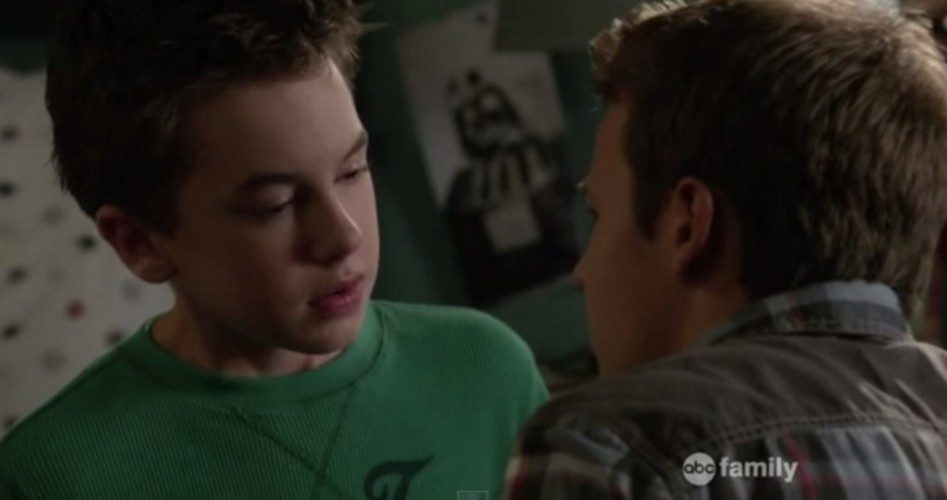
It’s certainly not your grandfather’s family programming. Not all kinds of history should be made, but this didn’t stop the ABC drama The Fosters from airing the youngest ever same-sex kiss Monday night — between 13-year-old boys (shown).
Unfortunately, the kiss was hardly out of place on The Fosters. Co-created by actor, director, and screenwriter Peter Paige — who claims to be “married” to a man — the program, to quote the Daily Beast, “is already lauded as one of the most progressive shows on TV.” As Raffy Ermac at homosexual site Advocate.com describes it, “The Fosters, which premiered on ABC Family in June 2013, centers on lesbian couple Stef and Lena (actresses Teri Polo and Sherri Saum) and their family; they are parents to Jude and four other children. The show last year brought in a transgender male character named Cole (played by the nonbinary actor Tom Phelan).”
“Non-binary” is one of today’s ever metastasizing “genders” and is applied to people who, writes Slate, “disregard the idea of a male and female dichotomy, or even a male-to-female continuum with androgyny in the middle. For them, gender is a complex idea that might fit better on a three-dimensional chart, or a multidimensional web.” Note that “gender” is not synonymous with “sex,” but refers to a person’s perception of what he is; consequently and as The New American reported Monday, it’s now becoming more accepted that your “gender” can be whatever you imagine it to be.
The Monday night kiss occurred between 13-year-old characters Jude and Connor, whose “chemistry had been bubbling, with subtle flirtation emanating from both sides,” wrote the Daily Beast, as it gushed over the event, treating it like merely an updated version of Romeo and Juliet.
But not everyone is so taken with Romeo and Romeo. As Breitbart reported, The Fosters “already pushes the limits in the eyes of some, who have raised questions regarding what constitutes modern family programming. The watchdog group One Million Moms boycotted the show immediately after it was announced in 2012.” Breitbart then quotes the group as having stated, “Obviously, ABC has lost their minds…. One Million Moms is not sure how the explanation will be given on how the biological children were conceived. None of this material is acceptable content for a family show … Let’s stop this dead in it its tracks.”
Unfortunately, it’s morality being stopped dead in its tracks — and the young are a primary target. Evidencing this, The Fosters was hailed in 2014 by Vulture.com as “the year’s best teen show,” and Boston Herald critic Mark Perigard wrote in 2013, “The show cannily plays to teen hopes and dreams.” But what is the show “cannily” trying to accomplish?
Note that if “a picture is worth a thousand words,” video — innumerable moving pictures seamlessly flowing together like points on an arc — is worth countless millions. People are influenced by and learn from others, and television is a powerful medium that engages the senses of sight and sound and brings other people and their behaviors and ideas into Americans’ homes every day. The average youth would be unlikely to become well acquainted with a person with anomalous sexuality, but TV can make a “visit” by such an individual a regular occurrence.
Also understand that young children have difficulty differentiating between fiction and reality. As former West Point military psychologist Lt. Col. David Grossman has put it, when little children see something on TV, “to them it is as though it were actually happening.” I witnessed this myself with a seven-year-old I knew who had watched numerous old Godzilla films and insisted that “it really happened.” To a wee child, image can be reality — even if it’s twisted imagery.
Of course, older children and youths don’t have this deficiency, but the point is that TV and film are powerful forces for shaping public opinion and, more importantly, emotion. Emotion is a seductive siren hard to resist, which is why Ben Franklin observed that you “cannot reason a man out of a position he has not reasoned himself into.” It is also a reason why the Barna Group research company found, during polling showing moral relativism to be the norm today, that “Americans are most likely to base [conception of] truth on feelings.”
Thus have propagandists, from Hitler’s filmmaker Leni Riefenstahl to the Soviets to the North Koreans today, long used emotion-manipulating entertainment to mold minds. And America’s libertine sexual revolutionaries are no exception. Just consider, for example, homosexual activists Hunter Madsen and Marshall Kirk. In their book After the Ball: How America Will Conquer Its Fear and Hatred of Gays in the 90’s, they called, as I pointed out in “The Acceptance Con,” “for a desensitization of Americans to homosexuality via a ‘continuous flood of gay-related advertising,’ a ‘conversion of the average American’s emotions, mind, and will, through a planned psychological attack, in the form of propaganda fed to the nation via the media.’” (Emphasis added.)
And what have we seen the last 40 years? As I wrote in “The Slippery Slope to Pedophilia”:
Of course, Kirk and Madsen weren’t puppeteers or prophets as much as good trajectory readers, as the movement they encouraged was well under way by the time they penned their book.
In 1977 already, we had the sitcom Soap with its openly homosexual character Jodie, played by comedian Billy Crystal. And while some would argue that the character was created to make the show cutting edge rather than to manipulate hearts (and, of course, both could have been motivations), it certainly made for ingenious propaganda. Take a funny and sympathetic character — and Crystal was most comedic — but make him a homosexual on an entertaining show that is the “thing to watch.” This is effective because whether it’s Soap, La Cage aux Folles, or another work, if you laugh at something enough, you’re no longer outraged by it. Also be sure to have that homosexual character say things such as “I’m a person, just like you,” which Jodie did (or a paraphrase of it), but, most significantly, just show him acting, and interacting with others, just as you would. For a big part of normalizing something is showing those who embody it acting normally.
The next step after normalization and tolerance is engendering sympathy and affection, and entertainment’s role in this is simple to understand. Just as people may condemn the sin but not the sinner, they also have trouble loving the sinner but not the sin. This is why a mother may accept even a son’s heinous crimes and why people will justify the scandalous behavior of a favorite politician or sports figure. Likewise, when people come to like a show — and, more specifically, a character on it — they generally start to accept what that character represents. And just think how successful this entertainment campaign has been. Homosexual characters are now a staple of TV and film and, as in the movie Sling Blade, are sometimes the work’s only compassionate voice of reason.
And now entertainment has moved to another point on the cultural trajectory: contributing to the legitimization of homosexual behavior among youths barely past puberty. It’s the Experiment Thesis: Take, as the Daily Beast put it, a “journey of self-discovery” and learn your sexuality, kiddo. Try it; you may like it. But the problem with trial and error, whether it’s arranging the life of one citizen or one civilization, is that it leads to a lot of trials and errors.
Photo: Jude and Connor in The Fosters



